Chapter 53 Identifying and Treating Common Insect Pests
Insects are found nearly everywhere, from underwater and deep in soil to the highest alpine peaks. Their success depends on many factors, but the two that are most important for us are their ability to survive adverse conditions, and their reproductive capacity.
Many species overwinter as eggs that can withstand repeated freezing. In others, adults hide in leaf litter or in cracks of bark, then start reproducing as soon as they emerge in spring. Overwintering pest insects emerge and immediately look for hosts so they can build up energy for mating and laying eggs. Insects also are reproductive factories. Females can lay hundreds of eggs, and many species produce several generations a year. This is why insect pests seem to appear suddenly in huge numbers.
Most insects go through one of two life cycles. The differences between predator and prey life cycles is not just academic. They can help us control pests more effectively.
Pest species that are important to bonsai have short, incomplete life cycles, consisting of an egg, several larval stages, and a sexually mature adult. The larvae look like immature adults and usually feed on the same hosts.
Beneficial predatory insects usually have longer, complete life cycles. Their larval stages look nothing like the adult, and they must pass through a resting pupal stage in order to transform into adults. In some cases (ladybugs for example) larvae and adults may eat the same prey. In others (lacewings for example) larval and adult stages eat different diets.
53.1 Bonsai’s Major Offenders
It is not necessary to catalog every possible insect that might attack bonsai trees. A few groups cause most of the damage. These chief offenders are described below along with their most common targets. Many of these pests are very small; you may need to get out your magnifying glass.
Control strategies are organized around IPM principles. Always start with less aggressive method first. Only move up to more toxic chemicals if the infestation is severe and is not controlled by earlier steps. Be sure to eliminate any underlying physical conditions that favor the pests, and if possible provide conditions that attract or encourage predators that feed on the pest.
53.1.1 Aphids
1. 
2. 
Aphids. 1. Close-up of a group of aphids. Middle: stem covered in wooly aphids. 2. Close-up view of aphids (right) and a ladybug larvae predator (left).I imagine the aphids look at this predator like we would look at a hungry lion or bear. Link to original images: image 1; image 2
There is no such thing as just one aphid. They invariably seem to suddenly appear in large numbers. They are tiny (<1/8”) green, brown, or black, flattened, winged or wingless. Woolly aphids are white with cottony patches. Many have long antennae folded back over their bodies. Aphids have mouths like mosquitoes, but they suck plant juices instead of blood.
Aphids are the most prolific insects on the planet. Aphids reproduce asexually and begin reproducing live young within days of birth. So only a few need to get onto a tree to establish a large population quickly. They bear live young all summer without mating. Males and eggs are produced as the weather cools; only eggs overwinter. They have a very short, incomplete life cycle, and the juveniles feed just as heavily as the adults.
53.1.1.1 Commonly Affected Trees
Almost any tree or plant can host aphids. Apple and crabapple, beeches blueberries, bougainvillea, citrus, cotoneaster, elms, firs, hawthorn, maple, pyracantha, and tropicals (especially while indoors) seem particularly susceptible here.
53.1.1.2 Symptoms
Aphids feed on plant sap by inserting a needle-like stylet into green tissue. Unlike chewing insects and spider mites, aphids do not leave behind obvious damage marks. Individuals line up along newly emerged stems and veins of young leaves. Infestations usually start on the underside, and move to the exposed upper sides of branches and leaves as the population grows.
Many aphids secrete honeydew as they feed; look for sooty mold or sticky spots on leaves. Severe infestation causes shriveling and stunting of leaves, or leaf drop.
53.1.1.3 Cultural and Physical Controls
Aphids are very soft-bodied, so they can be killed by spray from a garden hose. Some sources suggest using woven mesh covering to prevent aphids, but this is not particularly effective for woody plants.
Moving trees into brighter sunlight can scald the beasts. Move tropicals outdoors so natural predators can reach them.
53.1.1.4 Chemical Controls
Aphids are killed readily by insecticidal soap, and neem or summer horticultural oil. Synthetic insecticides rarely are needed for aphids, but in extreme cases, use malathion or acephate.
53.1.1.5 Biological Controls
Many beneficial insects feed on aphids, which is a good reason to avoid synthetic insecticides. Aphid lions (green and brown lacewing larvae) feed voraciously on aphids. Damsel bugs, spiders, aphid midges, Braconid wasps, soldier beetles, hoverfly larvae, minute pirate bugs, and ladybugs also prey on aphids.
53.1.2 Spider and other leaf mites
1. 
2.  3.
3. 
4. 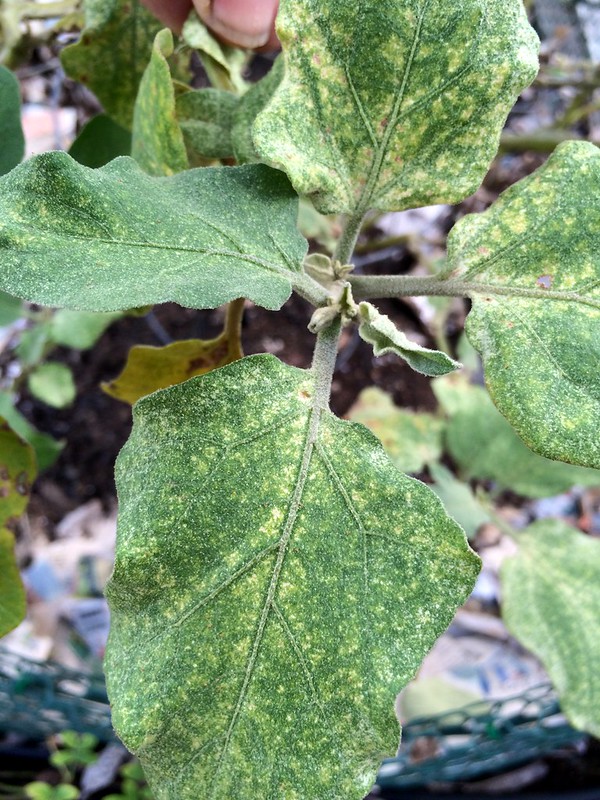
Spider mites. 1. Red mites on underside of a leaf.2. Ttwo-spotted spider mites. 3. Spider webs that are a symptom of spider mites. 4. Foliage stippling caused by mites feeding. Links to original images: image 1; image 2; image 3; image 4.
Eight-legged relatives of spiders and ticks. Individuals are tiny, the size of finely ground black pepper flakes or smaller. Colors include white, yellow, tan, green, red, black, or spotted. They have a more complex life cycle, but still reproduce every 5-7 days. Both adults and eggs overwinter. They are sap feeders that suck juices, causing leaves to discolor or drop. They also transmit several plant viruses.
53.1.2.1 Commonly Affected Trees
All fruiting trees, azaleas, broadleaf evergreens, citrus, cotoneaster, hemlocks, hollies, junipers, pines, rhododendron, spruce, yew.
53.1.2.2 Symptoms
Look for fine spotting, mottling, or scaly russet patches on leaves. Bronzing or scorched looking leaves indicate more serious infestation. Spider mites spin tiny fine webbing between infested leaves and branches. Check susceptible trees regularly; once symptoms appear, the infestation is already severe.
53.1.2.3 Cultural and Physical Controls
The trouble with mites is their numbers, not their toughness. Dry air encourages them; spraying down foliage regularly is a major deterrent. Be sure to turn the hose on the undersides of leaves and branches. Keep debris cleaned out of pots to eliminate hiding places.
Like insects, some mites are predators. You can purchase and release predatory mites, as well as predators that target mites such as minute pirate bugs (Orius sp.)
53.1.2.4 Chemical Controls
First Tier
Mix 6 drops of Dawn dish soap in 1 quart of water. Spray trees thoroughly including under leaves, twice daily for 2-3 days.
Mild infestations can be controlled with insecticidal soap. In spring, spray trees that had an infestation LAST season with neem oil to reduce the odds of recurrence.
Second Tier
Most insecticides do not kill mites. If insecticidal soap fails, use a product that contains fembutatin oxide or other broad spectrum miticide, like Ortho Systemic Insect Killer, Isotox, or other product specifically labeled for use against mites. Repeated application may be neededUse caution, as some trees do not tolerate systemic toxins.
DO NOT use malathion. It does not affect mites, but DOES kill their predators.
Biological Controls
Like insects, some mites are predators. You can purchase and release predatory mites the same as you would insect predators such as ladybugs and minute pirate bugs (Orius sp.)
53.1.3 Mealybugs
1. 
2.
3. 
Mealybugs. 1. A single citrus mealybug. 2. Branch coated in mealybugs. 3. Underside of a leaf with both mealybugs and scale. Links to original images: image 1; image 2; image 3.
Mealybugs range from 1/12-1/4 inch or more across, oval to round, and are covered with white, pale grey, or pinkish fluff. They have an incomplete life cycle, so a range of sizes usually are present. Like aphids they suck plant juices through a sharp beak.
A single scale female can lay several hundred eggs, so an infestation can get out of control very quickly. Small juveniles will crawl around to find new food sources. Mature bugs are relatively stationary.
53.1.3.1 Commonly Affected Trees
Outdoors, the trees most susceptible to them include azaleas, bay, beech, citrus, euonymous, hollies, junipers, some maples, pines, privet, and rhododendron. Any plant or tree kept indoors is a potential host for mealybugs. Fukien tea and citrus seem to be magnets for them.
53.1.3.2 Symptoms
Look for white fluffy patches on the undersides of leaves
53.1.3.3 Cultural and Physical Controls
Mealybugs are hard to knock down once established. Watch trees closely and treat sooner rather than later. If possible, prune off branches that are heavily infected.
Spray stems and branches with the hose to knock off most of the biomass. Then use follow-up treatment.
53.1.3.4 Chemical Controls
First Tier
Neem oil can suffocate mealybugs, but it can be hard to get it applied to the undersides of the leaves.
Second Tier
Malathion works to keep mealybug numbers down but will not kill a large population easily.
53.1.3.5 Biological Controls
Predatory beetles and wasps are available that can help keep scale in check. The specialist predator called mealybug destroyer can be difficult to get established. If aphids are not readily available, lacewing larvae attack small mealybugs instead.
53.1.4 Scale insects
1. 
2. 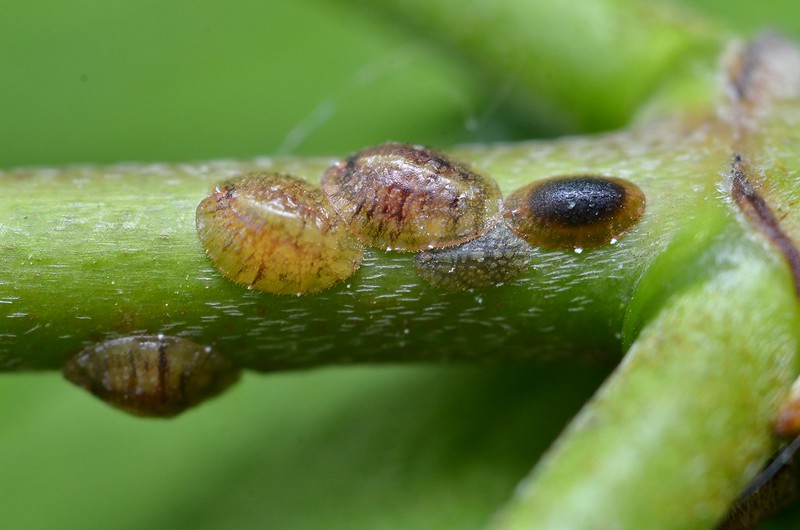
3. 
Scale insects. 1 and 2. Armored scales. 3. Cushiony scale. Links to original images: image 1; image 2; image 3.
Armored scales are more common in this area. They range from 1/12-1/4 inch across, oval to round, and broadly cone-shaped. Colors range from tan to brown or bronze, rarely black. Cottony scales are less common. They are slightly larger, and are covered with white, pale grey, or pinkish fluff. Scales have an incomplete life cycle, so multiple sizes usually are present. Like aphids they suck plant juices through a sharp beak.
53.1.4.1 Commonly Affected Trees
Apple and crabapple, azalea, beech, camellia, citrus, euonymous, holly, jasmine, junipers, maple, pines, privet, rhododendron.
53.1.4.2 Symptoms
Mature armored scale are sedentary, and rarely move. Their overlying shell is resistant to most chemicals. Adults shield their eggs under it until they hatch. Armored scale are most vulnerable when the soft “crawlers” disperse looking for new places to park and feed. Cottony scales are not so heavily armored, and move about more readily.
A single scale female (armored or soft) can lay several hundred eggs, so an infestation can blow up very quickly. Both eggs and adults of hard scale can overwinter. Only the eggs of soft scales survive freezing.
Like aphids, scale secrete honeydew that leads to sooty mold or sticky spots on leaves. Leaves and needles appear stunted, yellow or otherwise discolored, or spotted. Stems with heavy infestations are covered with shiny dark spots or warts.
53.1.4.3 Cultural Controls
Prevention is the best strategy for managing scale. Isolate trees that have scale well away from other trees, and clean tools with bleach or alcohol to eliminate cross-contamination. Do not compost pruned materials; put them in plastic bags and put in garbage for disposal.
53.1.4.4 Physical Controls
A small number of armored scale can be picked off by hand with forceps. Alternatively, dip a Q-tip in rubbing alcohol and touch it to each insect to kill them, then wash off the carcasses with a hose. Fukien tea is very sensitive to chemical controls, so for them these are really the only options.
53.1.4.5 Chemical Controls
First Tier
Spraying with light horticultural oil can reduce their numbers somewhat, but does not completely control scale.
Second Tier
Cushiony scale can be controlled using insecticidal soap and Malathion.
If you must use chemical control for armored scale, do not bother with Malathion; it only kills armored scale in the crawler stage. A systemic toxin like acephate usually is needed to control severe infestations.
53.1.4.6 Biological Controls
Predatory beetles and wasps are available that can help keep scale in check. If aphids are not readily available, lacewing larvae attack scale insects instead.
53.1.5 Whiteflies
1. 
2. 
3. 
White flies. 1. Underside of a leaf infested with whiteflies. 2. Close-up of a small group of adults. 3. Close-up of a single individual. Links to original images: image 1; image 2; image 3.
Pure white flies, less than 1/8” long that congregate on undersides of leaves. Adults and juveniles feed by sucking plant juices. Unlike many pests, whiteflies go through a pupal stage. They do not tolerate cold temperatures, so are more likely to infest tropicals.
53.1.5.1 Commonly Affected Trees
Azalea, holly, jasmine, rhododendron, tropical species, any trees indoors where humidity is high and there is still air.
53.1.5.2 Symptoms
Large numbers of white flies swarm up from foliage when disturbed. Often leaves are covered with sooty mold from their feeding.
53.1.5.3 Cultural, Physical Controls
These are persistent devils, so you want to avoid introducing them. Check all new trees before bringing them home. If whiteflies rise from a tree when you brush the foliage, don’t buy it.
If you suspect whiteflies, monitor trees using yellow sticky cards. If you catch more than one or two over the course of a day, start treatment because they have already laid eggs.
53.1.5.4 Chemical Controls
First Tier
Start with summer oil, then switch to insecticidal soap. Make sure to spray beneath the leaves where the adults hide.
Second Tier
Whiteflies quickly develop chemical resistance, so more extensive infestations require a three-step approach that alternates between toxins. Start with insecticidal soap plus horticultural oil. Five to seven days later, treat with malathion. After another 5-7 days, repeat the insecticidal soap. Wait 5-7 more days, and treat with acephate or similar systemic. Between treatments, keep trees in areas with good air circulation. Continue monitoring with yellow sticky cards. When you trap no more adults, wait 7 days, then check again. If adults reappear, start the cycle again with malathion.
53.1.5.5 Biological Controls
Generalist predators like lacewings eat whiteflies, but parasitic wasps (Encarsia sp.) that feed only on whiteflies provide better control. For the most part, ladybugs ignore whiteflies.
53.1.6 Wood Destroying Insects
1. 
2. 
Termites and ants. 1. Common subterranean termites. Darker headed individuals are soldiers, lighter ones are workers. 2. A carpenter ant collecting honeydew from “farmed” aphids. Links to original images: image 1; image 2.
Many insects attack dead or dying wood. The two greatest concerns for bonsai here in NC are subterranean termites and carpenter ants. Deal with these immediately; they can damage bare wood very rapidly.
Seeing even one worker termite above ground in a pot is a MAJOR warning sign. Fortunately all termite species found in NC are fully subterranean; they need to have a path or channel connecting their colony to the ground. They can be kept out of pots by moving containers at least six inches off of the ground, and preventing workers from connecting to pots via an earthen tunnel. Further preventative measures usually are not needed.
Ants usually do not damage healthy trees, but they are attracted to bare moist wood, especially underground. Several species specialize in excavating galleries into decayed wood, which lets in moisture and decomposition fungi. Also, several species will carry aphids to leaves and tend them like cattle so they can feed on the aphids’ honeydew.
Unlike termites, ant nests are not confined to the ground. A 1-gallon pot of soil can host a very large colony.
53.1.6.1 Control
Submerging a pot in a solution of 2 tablespoons of insecticidal soap per 1 quart of water for 20 minutes will kill both termites and ants, without harming the roots.
Most ants come to sugar water bait stations. Mix 2-3 tablespoons of table sugar and 1 teaspoon of borax (sodium tetraborate; look in the laundry aisle of the grocery store) into 1/4 cup of warm water. Cut 1-inch square pieces of wax paper or plastic, place them around the rim of the plant container, and add 2-3 drops of the sugar mixture. Within a few hours there may be dozens of ants feeding. Do not kill them; let them go back to their nest(s). When they share the sugar water they drank, they will pass the borate along as well. Most colonies collapse within 2-7 days.
The borate in borax powder is deadly for ants, but not for humans or pets. A small amount will not harm trees, but if a large amount of powder or concentrated liquid is spilled into a pot, flush it out by watering the tree until excess water flows out the bottom.
If you need a stronger treatment, fibronil is the insecticide most often used for termites and ants. It is modestly toxic to mammals, but highly toxic for insects, bees, aquatic life, fish, rabbits, and some lizards and birds. It also persists in soil for up to a year. Reserve this one for treating termite and large borate-resistant ant nests only.
53.1.7 Less Common Offenders
Several pests that still can damage trees if left unchecked, but are less likely to be a problem. They may be uncommon here, attack only a few species of trees, or cause mainly cosmetic damage. If the symptoms you see could be a major pest like aphids, or a minor pest like thrips, go with aphids and treat accordingly. Usually the treatment for the major pest will eliminate the minor ones as well.
53.1.7.1 Adelgids
1. 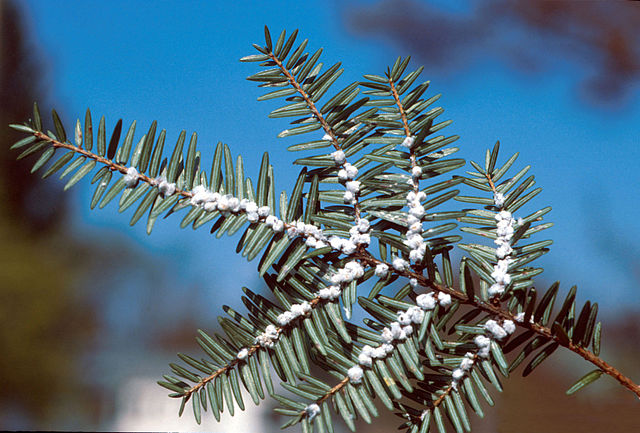
2. 
3. 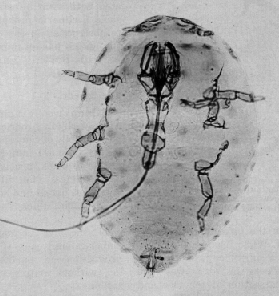
Adelgids. 1. Hemlock adelgids on a branch. 2. Close-up of a mass. 3. Micrograph of a single adelgid. Links to original images: image 1; image 2; image 3.
These aphid-like insects are the pests that decimated the hemlock and spruce forests covering Mount Mitchell and other high peaks of the southern Appalachians. They inject toxic saliva that kills needles and prevents new ones from growing. Reproduction is essentially the same as aphids. There is a winged form that can migrate long distances between host trees
Commonly Affected Trees
Firs, hemlocks, larches, spruces.
Symptoms
Look for white egg masses anchored along softwood branches and to bases of needles.
Controls
Do not wait to treat adelgids; they do not die out on their own, and they WILL kill the tree. Spray trees thoroughly with horticultural oil twice a year, June-August, then again October-April. If that fails, treat trees with acephate. There are no natural predators in the US.
53.1.7.2 Thrips
1.  2.
2. 
3.
Examples of thrips. Links to original images: image 1; image 2; image 3.
Extremely tiny (<1/20”) dark insects shaped like long thin rice grains. Their life cycle and habits resemble aphids.
Commonly Affected Trees
Birches, citrus, rhododendrons are most commonly infested.
Symptoms
Look for distorted leaves with pale irregular patches, where juveniles have scraped away the green plant cells. Extensive feeding resembles damage from mites, but nymphs are much larger.
Cultural Controls
Treat as you would aphids.
53.1.7.3 Twig Girdlers
1.
2. 
Twig girdlers. 1. A girdled twig. 2. Oncideres cingulataone_, one of several beetle species that clip twigs. Links to original images:_ image 1; image 2.
Commonly Affected Trees
All tree species can be affected by one or more species of girdlers, but deciduous trees are attacked more often.
Symptoms
Twig girdlers chew through small branches in which they have laid eggs. The branches break off and fall to the ground, where the eggs develop. These insects cause obviously visible damage, but ironically, are not particularly serious or common.
Controls
Clean up girdled twigs and burn them to disrupt the life cycle.
53.1.7.4 Leaf-Rolling and Chewing Insects
1. 
2. 
3. 
Rolling and chewing insects. 1. Basswood leafroller caterpillar in a damaged leaf. 2. Baldcypress leafroller. 3. Japanese beetles chewing on peach leaves Links to original images: image 1; image 2; image 3.
Many different species of insects (caterpillars in particular) roll up leaves to form shelters or cocoons. Leaf-cutting bees, various caterpillars, Japanese beetles, and some weevils chew holes in leaves.
Commonly Affected Trees
All tree species can be affected by one or more species of leaf-damaging insects.
Symptoms
Usually the insects or caterpillars that are damaging leaves are immediately visible. Some will hide under leaves if disturbed.
Controls
Use scissors to cut off rolled leaves, and dispose of them immediately in a closed container. For chewing insects, spray with malathion.
53.1.7.5 Leaf Miners
1. 
2. 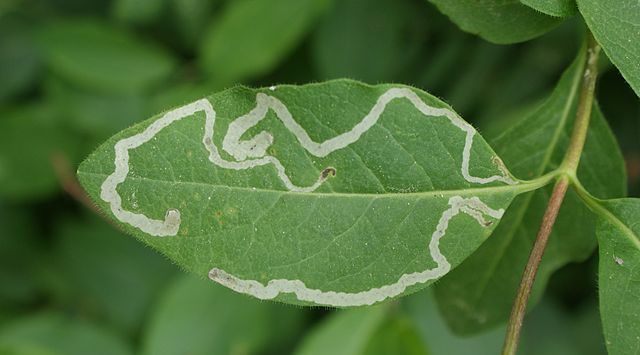
Two examples of leaf miner damage. image 1; image 2.
This is a catchall term for various small moth, beetle, and fly larvae that burrow in the space between the surfaces of leaves. Adults are rarely seen. The damage is mainly cosmetic.
Commonly Affected Trees
Often found on birch, boxwood, holly.
Symptoms
Look for pale irregular tracks in leaves.
Controls
Prune off individual infected leaves and bag them in plastic to break the reproductive cycle. Heavy infestations require a systemic like acephate; no other treatment will work.
53.1.8 Sawflies; Army, Oak and Spruce Worms
1. 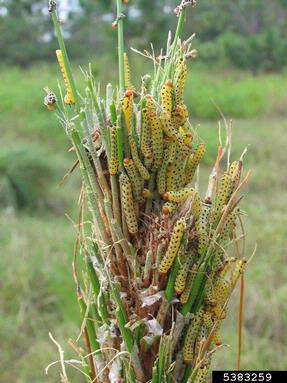
2. 
3. 
Sawflies. 1, 2. Pine sawflies. 3. Sawflies attacking deciduous leaves. Links to original images: image 1; image 2; image 3.
1. 
2. 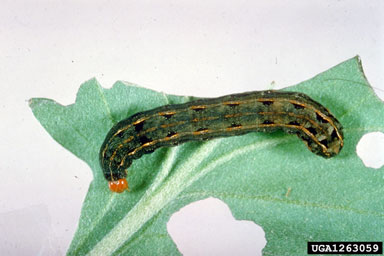
Armyworms. Links to original images: image 1; image 2.
1. 
2. 
3. 
Oak worms. 1. A single late instar oak caterpillar. 2. A group of oak caterpillars. 3. Red-hump oakworm moth caterpillars. Links to original images: image 1; image 2; image 3.
Commonly Affected Trees
Pine sawflies: hemlocks, junipers, pines. Army worms: all deciduous trees are susceptible to some degree. Oak worms: apple and crabapple; elms; hornbeams; oaks. Spruce worms: spruce.
Symptoms
Look for caterpillars on damaged foliage. Pine sawflies in particular can strip all the needles from a pine branch within a day or two.
Chemical Controls
Neem oil can both suffocate eggs and repel caterpillars. Sevin/carbaryl and Orthene/acephate are both effective treatments for chewing caterpillars.
Biological Controls
Bacillus thuringiensis is a bacterium that only infects caterpillars, and provides good control for a variety of pest species.
53.2 Tools for Controlling Insect Pests
53.2.1 Mechanical Aids
53.2.1.1 Garbage Can With a Tight Lid
Many pests overwinter in leaf litter in pots or beneath benches. Keep areas under and on top of benches free from plant debris. Prevent reinfestation by storing waste in a closed can before disposal.
53.2.1.2 Sticky Traps
Paper cards (usually yellow) coated with a tacky adhesive, serve two purposes. Small cards are used to continuously monitor for flying pests like whiteflies or mature aphids, that may not be present at the time of day you check your trees. Larger cards can attract and trap sufficient numbers of adults to disrupt their reproductive cycle.
53.2.1.3 Garden Hose
A fine spray from the garden hose can do wonders against mild to moderate infestations. Just knocking pest numbers down gives predatory species a chance to catch up.
53.2.1.4 Micronized Diatomaceous Earth
Finely powdered diatomaceous earth (DE) is made of finely ground shells of diatoms. The diatoms’ shells are nearly pure silica, which means diatomaceous earth is essentially powdered glass.
DE works as an insecticide because of its abrasive and physical properties. The fine powder adsorbs lipids from the waxy outer layer of the exoskeletons of many species of insects so that they desiccate and die. DE also repels slugs and snails but mainly because of irritation, not dehydration. Basically they are trying to crawl across broken glass.
Although considered to be relatively low-risk, diatomaceous earth is not inert. Chronic exposure can cause the lung disease silicosis. Use a dusk mask to avoid breathing the dust.
53.2.2 Horticultural oils
Oils kill insects by smothering them. The main difference is the density of the oil, which determines the season it is most appropriate for. There is little or no residual effect on insects that arrive after spraying, so they are safe for bees and migratory predators. Pay attention to package directions for mixing; improperly mixed oil or applying it at the wrong time can damage plants severely.
53.2.2.1 Dormant Oil
Derived from paraffin or other petroleum products. Thoroughly wet bark and CLOSED leaf buds to smother overwintering adults and eggs. Do not use on trees once buds swell, or on warm days.
53.2.2.2 Summer (aka, Light Horticultural) Oil
Mostly made from vegetable or citrus peel oils. They can be applied to foliage and bark year round, but are not particularly effective in cold weather. Spraying more often than monthly can distort foliage.
53.2.2.3 Neem Oil
Extracted from seeds from the neem tree (Azadirachta indica). The active compound is azadirachtin, a powerful feeding deterrent and hormone disrupter for insects that has been approved by USDA as an organic pesticide. Neem oil is touted as an IPM panacea, but read on before you run out and buy it. Raw neem oil is a complex mixture of biologically active compounds. When raw oil is removed from seeds and treated with alcohol, virtually all azadirachtin and related substances separate from the oil. The remaining oil, sans azadirachtin, is labeled Clarified Hydrophobic Extract of Neem Oil. Most commercial products are made with hydrophobic extract, so do not contain measurable amounts of azadirachtin. They are essentially the same as summer oil.
53.2.3 Insecticidal Soap
Insecticidal soap is a mixture of potassium salts of fatty acids. It dissolves an insect’s cell membranes, and they bleed to death. Insecticidal soap works best on smaller, soft-bodied insects. Fortunately, this includes most bonsai pests. Larger insects like bees and beetles that have tougher exoskeletons are not affected.
Mix insecticidal soap exactly as directed by the package. Both higher and lower concentrations may damage leaves and flowers. Some species used in bonsai are prone to damage, particularly jades, Japanese maples, some azaleas, and palms. Spray 1-2 leaves and check for damage 24 hours later before spraying the entire tree.
Insecticidal soap can be applied in combination with summer oil. Place 1 quart of water in a clean container, then add the amount of soap indicate by package directions. Mix, then add the specified amount of summer or neem oil to the same quart of water. Mix again, and pour into a sprayer. Mix regularly while spraying, and wet both upper and lower leaf and branch surfaces. Use prepared spray within 1 day; if stored any longer, it breaks down.
Do not use this mixture more than twice a growing season. Use soap alone for later treatments.
53.2.4 Insect growth regulators (IGRs)
Compounds in this group disrupt the hormones controlling insect growth and development. Depending on the insect species, these hormone regulators can cause adult sterility, physical deformities, water loss, or premature death.
Neem oil contains trace quantities of azadirachtin, a naturally occurring IGR. Precocene is another naturally occurring IGR that was first purified from blue flossflower (Ageratum houstonianum). This cool-season annual plant is sold in local garden centers. Pyriproxifen is a synthetic chemical that blocks the function of juvenile hormone (JH), while hydroprene and methoprene OVER-stimulate JH sensitive cells.
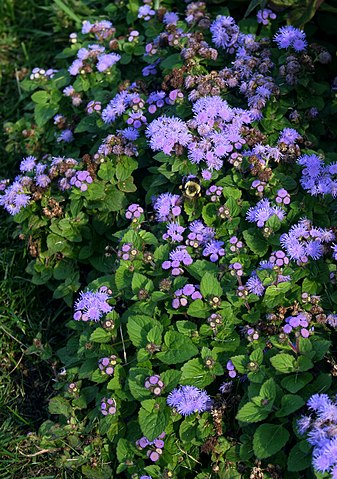
Blue flossflower, the original sourse of the IGR precocene. Link to original image.
IGRs are widely used as insecticides to control cockroaches, beetles, fleas, and moths. They also are effective against:
- Aphids
- Caterpillars, including armyworms
- Leafminers
- Scale
- Thrips
- Twig borers
- Whiteflies
IGRs are minimally toxic to mammals, but some are very toxic to aquatic life. IGRs can injure bees and beneficial insects, so be careful not to spray them beyond the trees to be treated.
Several synthetic IGRs are available commercially under the “Martin’s IGR,” “Bonide,” and “Gentrol“ brand names, among others. They are not available at stores locally, but can be ordered online from Amazon and other suppliers.
53.2.5 Chemical Insecticides
There are a bewildering number of choices available to consumers. Fortunately nearly all bonsai pests can be controlled with just a few. Turn to these if you do not get pests under control using oil, soap, or the hose. Do not rely on trade names (in parentheses); read the labels, and purchase based on the active chemical components in italics.
53.2.5.1 Less Toxic Pesticides
Malathion
Contact toxin. Despite its reputation, malathion has low toxicity and good safety profile. Routine occupational exposure is needed to cause harm. It works best on chewing insects that eat it, but it also kills soft-bodied sucking insects just by contact.
Fenbutatin Oxide
Fenbutatin is a long-acting mite killer, that does not harm predatory mites or most other insects.
Pyrethrins
Semi-synthetic or synthetic pesticides based on a toxic chemical found in some species of chrysanthemums. Pyrethroids are often found in household bug sprays. They are safe for humans, but not for many other animals we’d like to keep around. Pyrethroids are toxic to bees, dragonflies, and micro-invertebrates that make up the base of aquatic and terrestrial food webs. They are toxic to fish at extremely low levels. Some studies suggest that pyrethroids are toxic for cats as well.
Insecticides in this group include:
- Permethrin
- Allethrin, the first pyrethroid synthesized
- Bifenthrin, active ingredient of Talstar, and Ortho Home Defense Max
- Most all compounds with names ending in “-thrin”
- Transfluthrin, an active ingredient in Baygon
Pyrethroids break down in sunlight after 1-2 days, but when mixed into water they do not break down and remain lethal to aquatic organisms.
Piperonyl Butoxide
A synergist component of pesticide formulations. It has no pesticidal activity of its own; instead it enhances the potency of pesticides such as carbamates and pyrethrins.
53.2.5.2 More Toxic Pesticides
Carbaryl
Contact toxin sold under the name Sevin. Good for most chewing insects. Used sparingly, it has a good safety profile, but definitely reserve it for when other insecticides fail.
Acephate
Acephate (Orthene) is a systemic toxin that soaks into the leaves or roots, and makes the tree sap toxic to all sucking insects. Some references say acephate can damage maples, crab apples, and American elms, while others say to use it freely. My suggestion is to test it on a few twigs before coating an entire tree.
53.2.5.3 Do NOT Use Neonicotinoids!
This class includes the most widely used pesticides in the world, but they take a huge toll on honeybees and other beneficial insects. The compounds persist and accumulate in pollen and nectar, so preferentially kills beneficials that feed on flowers. They also appear to have delayed toxic effects, which is why they do not kill bees immediately, but weaken them and so contribute to colony collapse disorder. Given the risks to non-target species, neonicotinoids are not something we need in our arsenal.
Chemicals in this class include imidacloprid (the most widely used insecticide worldwide), acetamiprid, clothianidin, nitenpyram, nithiazine, thiacloprid and thiamethoxam.
53.3 Is Routine Preventive Spraying Appropriate?
Outdoor trees are susceptible to a variety of pests. Many trees will not show any signs though because insect predators help keep the pests in check. Occasionally though the pests multiply too quickly and start to damage a particular tree.
Trees that are affected at random can be treated as needed based on the pests or diseases that are present. If certain trees in your collection develop the same disease or are attacked by the same pests almost yearly, consider putting that tree (not the whole collection) on a routine preventive spray regimen.
First, clear out any dead leaves or debris where insects or the resting stage of a disease organism could hide. Spray the tree with a watering hose to dislodge the majority of insects.
Most potted trees can be sprayed routinely with insecticidal soap safely; I usually add summer horticultural oil (either citrus or neem oil, but NOT dormant oil) to smother larvae and eggs. Plan to reapply insecticidal soap a second time about 10 days later; do not use the horticultural oil more than once every 4-6 weeks.
53.4 Beneficial Predatory Insects
You now can buy and release hand-reared predators against most major pests. A good starting point for information is Cornell University (www.nysaes.cornell.edu/ent/biocontrol/). There is a separate page on beneficial insects.
If I had to pick one predator as a first choice to attract or release, it would be green lacewings (Chrysoperla sp.) The larvae, called aphid lions, eat up to 60 aphids a day for 2 weeks before pupating, then emerge to lay eggs of their own. If aphids are not around, larvae turn on other soft-bodied prey. Adults feed on pollen and nectar, so planting yarrow or other host plants in pots or beds near your trees will encourage them to stay.


